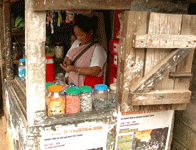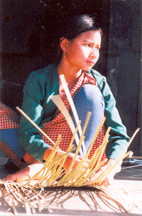Women of Meghalaya
Ms. Hasina Kharbhih
In India, we have three matrilineal societies and, of them, two are juxtaposed in the State of Meghalaya while the other is far away, in another part of the subcontinent. In spite of their proximity through historical reckoning, the Khasi, Jaintia and Garo societies are not only linguistically different; each is also unique in its structural and functional existence.
Khasi
| The people of Meghalaya being the followers of matrilineal social system, the Khasi women enjoy a special place. A Khasi woman is the guardian and preserver of the family goods. The children take their name from her. The mother, and through her authority, preserves the religious observances, usages and customs common to the family and society. Indeed, she plays a crucial role in the affairs of the family. The father has a definite role to play in the affairs of the family, but is limited by the final words of his brother–in–law. |
|
The inherent strength of the social system appears to be a structural balance or a synthesis between the authority enjoyed by the maternal uncle, father and mother. In its pristine glory the social system endeavoured to bring out the best from among the three units of authority by clearly defining their respective roles.
|
|
|
Much as the women enjoys a high status, yet she does not have any power or position in the political system. She is not entitled to attend the durbars, be they at any level – village, territory or State. Politics is confined to men. But she is the keeper of the trust of the property and goods at home. And although the uncle does have a dominating role, he cannot ignore the father’s advice.
Marriage is considered carefully after both families agree. As they take descent from the mother, they carry not only the mother’s surname but also the family clan’s name. Marriage within the same clan is strictly prohibited. It is considered to be a most heinous crime. This rule is strictly followed even today.
Khasi women hold all real estates and properties as well as the family jewels, and, at least locally, the highest priestly office is held by a woman. Nevertheless, the husband may kill an adulteress wife.
Jaintia
The present Jaintia society is also matrilineal. The clan name or surname is traceable to the mother. The elementary unit of a tribal society is the family. But a family, in the local usage, means the person to whom the house belongs, that is the mother, the woman. A house consists of the mother and her children. The children may be married or unmarried. But it matters little to the family or to the mother. The married son is permitted to spend the night in his wife’s house only. The daughters and sons stay with the mother, work for her and help the family collectively.
The place of women is predominant in Jaintia society even today. She is the power or force behind bearing and sustaining children. She has to work in the fields to feed her children. She is the principal force, and so she should not be violated or abused at any time. The mother force is the root of all well –being. It is perhaps because of this spirit the rape, abduction etc, are considered unpardonable and despicable sins. One noticeable point in the Jaintia society is the absence of crimes against women. They respect the mother as the earthly god. Here a woman does everything – marketing, trade, cultivation without any fear of sexual harassment. It is this attitude which ordains a man to propose marriage to a girl. Coercion in wedding matters is noticeably absent. It is the mother who controls the earnings of even a married son. In the backdrop of man – power scarcity, a female child is a valuable asset for the family. So, the female child gets preferential treatment. Women are more advanced in education, and in this respect, this society is well ahead of others. The roll strength of the colleges shows that 40 per cent are females; but the percentage of pass sometimes borders on 50 per cent. The psychology behind this may be that the boys may not stay with the mother after marriage, but the girls will. Though the influence of modernity, Western education and conversion to Christianity is gradually changing the social outlook, old habits and attitudes have not been completely washed away yet. In some places, the ‘visit – marriage’ is being replaced by ‘migration – marriage’ (by the groom) resulting in the corrosion of mother control.
The mother is the temporal and spiritual head. She is the house priest, and it is she who is to offer food to the dead ancestors. She should encompass and contain her children even after death. So, the bones of the children should be kept with her in one place.
Garo
In Garo society, the woman plays an important role. She does not go to her husband’s house, but her husband is captured by the young boys of the village and is brought to her for marriage. It is she who selects the boy and permits him to become the head of the family – nokma. These matters very little, however, because nokmanship does not, in reality, confer much authority. The nokma (her husband) does not direct the villagers in their work or make more decisions than the others.
The Garos follow the matrilineal system in tracing relationship. Hence the heir to the property is a daughter and not a son. A woman enjoys a higher status in the Garo society. She advises her brother to look for a suitable match for her son or daughter. It is a common understanding that the maternal uncle’s daughter is the best match for the boy. Thus, the property does not go out of the fold. Monogamy is the general rule among the tribals, but cases of polygamy are also found in the interior areas. Polyandry (a woman having several husbands) is not found in this tribe. Divorce raises great complications.
The Garos believe in the institution of cross – cousin marriage. In sharp contrast to the Garo society, the Khasis never institutionalized cross – cousin marriage as a way out of the impasse, although theoretically there could be no bar to it, as the children belong to the mother’s clan. It may be mentioned that the Khasi custom definitely forbids a marriage (cousin marriage), which is the pivot of the Garo system that roots on the maintenance of dual interest in the estate. So far, there has been no evidence at any kind of preferential or prescribed cross – cousin marriage among the Khasis and the assumption that the Khasi society has passed though a dual system cannot be sustained.
Among the Khasis, if a married couple get on well together and after the birth of one or two children, the husband takes his wife and family to a house of his own, and after the wife leaves her mother’s house, she and her husband pool their earnings, which are expanded for the support of the family. The non – heiress in a Khasi matriliny has no attachment to ancestral agricultural land, nor does she belong to a corporate property group as in some other matrilineal societies. Women in Khasi society do not form new segments of the matrilineal group through their children; they pass on the right of membership as an undifferentiated whole. The situation of the non – heiress who is excluded from the property under the Khasi matriliny is unique, and represents quite in opposite picture.
In the Garo system, the Garos form a domestic unit or co – residential group which is also a productive unit, and cultivate the common village land called a king, the ownership of which theoretically vests in the headman’s wife representing the direct line descent of the founder of the village, in contrast to a Khasi village. A Garo village is homogenous – being the seat of a localized lineage group. The Khasi village, on the other hand, is composed of different clans and clan lineage groups.
Photographs: Ghani Zaman
References:






